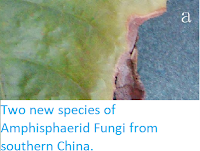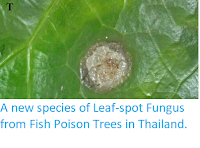Cup Fungi, Helotiales, are Ascomycote Fungi with distinctive cup-shaped fruiting bodies that typically live as saprophytes (organisms that gain nutrition by breaking down dead organic matter) in soil, or on rotting wood or manure. This group also includes species that form mycorrhizal associations with Plants of the Order Ericales, enabling them to live in acid soils which many other species cannot colonise, as well as pathogenic species which infect Plants. Members of the genus Stamnaria are saprophytes growing exclusively on decaying Horsetails, Equisetum. They are asexual, and produce yellow-to-orange fruiting bodies covered by a thick gelatinous layer.
In a paper published in the journal MycoKeys on 20 March 2018, Danny Haelewaters of the Department of Organismic and Evolutionary Biology at Harvard University, Nina Filippova of Yugra State University and Hans-Otto Baral of Tübingen in Germany describe a new species of Stamnaria from a tiaga forest in the Khanty-Mansi Autonomous Okrug (or Yugra State) of Western Siberia.
The new species is give the name Stamnaria yugrana in reference to the area where it was found. This species produces yellow cups 0.5-1.0 mm in height and 0.25-0.6 mm in diameter, with a distinctive whitish collar. The species was found growing on fallen branches of the Wood Horsetail, Equisetum sylvaticum, in an area of coniferous woodland that had been cleared by a forest fire and subsequently colonised by the Horsetails.
Apothecia of Stamnaria yugrana on side branches of Equisetum sylvaticum: (A) Apothecia grown in situ under well-lit conditions. (B) Apothecia grown in shady conditions after incubation in a moist chamber. (C) Median section through an apothecium after incubation in a moist chamber. Scale bars: (A) 1.0 mm, (B), (C) 0.5 mm. Haelewaters et al. (2018).
The area has a sub-Arctic climate with an average yearly temperature of -1.1 °C, with monthly average temperatures ranging from -20 °C in January to 18 °C in July. The area is typically covered by snow from November to April, and is covered by mixed coniferous and deciduous woodland, with occasional forest fires that clear patches, allowing herbaceous communities dominated by Horsetails and Arctic Brambles, Rubus arcticus, to thrive until the forest regrows.
Study site of Stamnaria yugrana growing on litter of Equisetum sylvaticum in Western Siberia near the Khanty-Mansiysk town. Haelewaters et al. (2018).
See also...
Follow Sciency Thoughts on Facebook.








